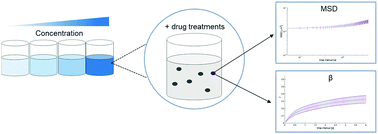Characterization of the mechanical properties of cancer cells in 3D matrices in response to collagen concentration and cytoskeletal inhibitors†
Abstract
Cellular processes, such as cell migration, adhesion, and proliferation depend on the interaction between the intracellular environment and the extracellular matrix (ECM). While many studies have explored the role of the microenvironment on cell behavior, the influence of 3D matrix mechanics on intracellular activity is not completely understood. To characterize the relationship between the mechanical components of the microenvironment and intracellular behavior, we use particle-tracking microrheology of metastatic breast cancer cells embedded in 3D collagen gels to quantify the intracellular activity from which the molecular motor activity and stiffness can be determined. Our results show that increasing collagen concentration of the 3D environments leads to an increase in intracellular stiffness and motor activity. Furthermore, our studies demonstrate that intracellular fluctuations depend on collagen concentration, even in the presence of a number of frontline chemotherapeutic and anti-MMP drugs, indicating that ECM concentration is an important and indispensable parameter to consider in drug screening.



 Please wait while we load your content...
Please wait while we load your content...